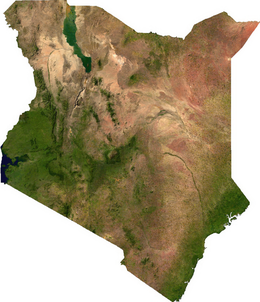Our website is made possible by displaying online advertisements to our visitors.
Please consider supporting us by disabling your ad blocker.
Geography of Kenya
 | |
| Continent | Africa |
|---|---|
| Region | East Africa |
| Coordinates | 1°00′N 38°00′E / 1.000°N 38.000°E |
| Area | Ranked 48th |
| • Total | 580,367 km2 (224,081 sq mi) |
| • Land | 98.07% |
| • Water | 1.93% |
| Coastline | 490 km (300 mi) |
| Borders | 3,446 km (2,141 mi) |
| Highest point | Mount Kenya 5,197 metres (17,051 ft) |
| Lowest point | Indian Ocean 0 metres (0 ft) |
| Longest river | Tana River (Kenya) (wholly within Kenya) 800 km (500 mi) |
| Largest lake | Lake Turkana 6,405 km2 (2,473 sq mi) |
| Exclusive economic zone | 116,942 km2 (45,152 sq mi) |


The Geography of Kenya is diverse, varying amongst its 47 counties. Kenya has a coastline on the Indian Ocean, which contains swamps of East African mangroves. Inland are broad plains and numerous hills. Kenya borders South Sudan to the northwest, Uganda to the west, Somalia to the east, Tanzania to the south, and Ethiopia to the north. Kenya currently faces border disputes with South Sudan over the Ilemi Triangle and with Somalia over Jubbaland where, if the Somalian Government gives it up, it could be a new part of Kenya, which would bring the total land area of Kenya to approximately 692,939 km2.
Central and Western Kenya is characterized by the Kenyan Rift Valley and central Province home to the highest mountain, Mount Kenya and Mount Elgon on the border between Kenya and Uganda. The Kakamega Forest in western Kenya is a relic of an East African rainforest. Much bigger is Mau Forest, the largest forest complex in East Africa.
Previous Page Next Page


